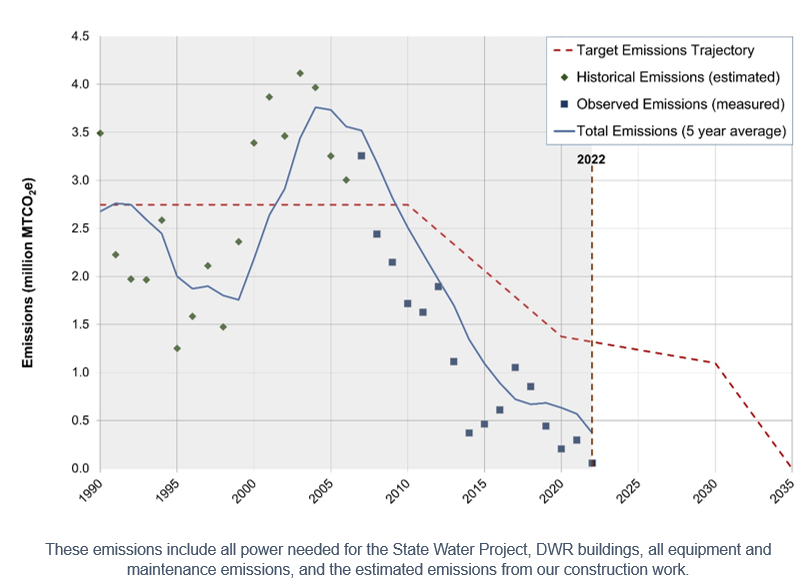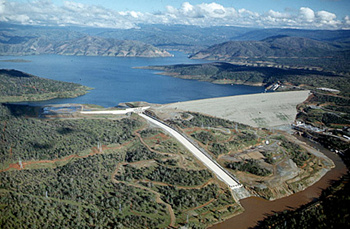Climate Action Plan
The Climate Action Plan is the Department’s guide to addressing climate change in the programs, projects, and activities over which it has authority.
Our Climate Action Plan is divided into three phases to address mitigation, adaptation, and consistency in the analysis of climate change:
- Phase I: Greenhouse Gas Emissions Reduction Plan (Update 2023) lays out DWR's greenhouse gas emissions reduction targets and the strategies to achieve these goals. To reflect the latest reduction targets and associated state regulations, an update (with supporting documents) has been prepared, highlighting the latest actions and policies to meet both near-term and long-term emissions reduction goals.
- Phase II: Climate Change Analysis Guidance develops a framework and guidance for consistent incorporation and alignment of analysis for climate change impacts in DWR’s project and program planning activities.
- Phase III: Climate Change Vulnerability Assessment (VA) describes, evaluates, and quantifies the vulnerabilities of DWR’s assets and business to potential climate change impacts. The Phase III: Adaptation Plan (AP) will help prioritize DWR resiliency efforts such as infrastructure improvements, enhanced maintenance and operation procedures, revised health and safety procedures, and improved habitat management. The State Water Project Adaptation Strategy provides State Water Project specific climate adaptation strategies and analysis.
A Climate Action Plan for the California Department of Water Resources, published in the Journal of American Water Works Association (JAWWA), recounts the significant drivers, lessons learned, and the road ahead for the Department's three-phased Climate Action Plan.

DWR will achieve carbon neutrality by 2035 and will supply 100 percent of its electricity load with zero-carbon resources by this date.
The Greenhouse Gas Emissions Reduction Plan guides the Department’s project development and decision making with respect to energy use and GHG emissions. Updated in 2023, it has identified 12 GHG emissions reduction measures to meet its 2035 commitments, including:
- Continued efficiency improvements to DWR’s existing facilities
- Purchase and development of renewable and zero carbon energy sources
- Comprehensive improvements to DWR’s construction practices
- Adjustments to DWR’s business activities that will reduce GHG emissions
In total, these measures will reduce annual GHG emissions by over 2.7 million metric tons per year in 2035.
Learn more about DWR’s carbon neutrality commitment at the Net-Zero Portal (NZP), an online platform for tracking and comparing global net-zero GHG pledges and pathways.
The California State Water Project, owned and operated by DWR, delivers water to about 25 million Californians and 750,000 acres of irrigated farmland. Getting water to these users requires a large amount of electricity. In fact, the State Water Project is one of the largest single consumers of electricity in the state, using around 8,000 gigawatt-hours per year. The State Water Project also generates a large amount of electricity each year at its reservoirs and in-conduit generating stations. The State Water Project actually generates about half of all the energy it uses each year. Even with all of the electricity the State Water Project uses, it only accounts for about 3% of statewide electricity use.
We identified a critical need for consistent departmental analysis and alignment of climate change impacts on the wide array of project and program planning activities we conduct. Climate change analysis can be extremely complex, as it must account for large uncertainties about future climate conditions and their impacts. This DWR Climate Action Plan will ensure that all DWR planning activities meet standards for quality, scientific rigor, and consistency. Phase II Climate Change Analysis Guidance establishes a two-step process for DWR project managers to screen for and evaluate risks to planning and operational activities posed by climate change.

The Phase III Climate Change Vulnerability Assessment (VA) provides the first comprehensive evaluation of DWR’s vulnerabilities to expected increases in wildfire, extreme heat, and sea-level rise, as well as to changes in ecosystems and long and short-term hydrology due to climate change. The VA identifies the activities performed and specific assets owned and/or operated by DWR that have vulnerabilities related to climate change.
A supplemental report, the Decision Scaling Evaluation of Climate Change Driven Hydrologic Risk to the State Water Project, documents a joint endeavor of DWR and academic partners to improve planning for the uncertain effects of climate change on the California State Water Project by integrating vulnerability-based analysis with traditional risk-based assessment methods. Results of the Decision Scaling report are featured in an online story map.
The Phase III Adaptation Plan (AP) will help prioritize DWR resiliency efforts such as infrastructure improvements, enhanced maintenance and operation procedures, revised health and safety procedures, and improved habitat management.
